The Ultimate Guide to Asscher Cut Diamonds
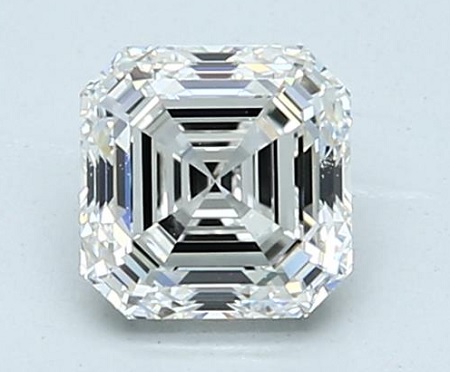
Asscher cut diamonds have a classy, hypnotic windmill patterning.
If you love art or vintage jewelry from the Art Deco period, you would likely find Asscher cut diamonds appealing to your tastes. This incredible cut has an understated, elegant look to it and shares some similarities with the emerald cut.
Asscher diamonds feature stepped cut facets and are generally squarish in shape. They are generally not as brilliant as other shapes because of their step cut but they give off a classy vibe that makes them really unique.
In this section of Beyond4Cs.com, you are going to find out everything you need to know about the Asscher cut diamond. I’m also going to reveal the insider tips that jewelers don’t want you to know and show you exactly what to look for to get a stunning Asscher diamond.
Let’s jump right in…
Here is a list of topics we will be covering:
- A Quick Historical And Technical Overview
- Different Faceting Styles And Their Impact on Appearance
- Best Proportions For an Asscher Cut Diamond
- Length to Width Ratios For Asscher Cut Diamonds
- Recommended Color and Clarity Ratings for Asscher Diamonds
- Don’t Forget to Check The Windmills!
- Case Study: 2 Asschers With Similar Proportions But Look Different
- Best Asscher Cut Engagement Ring Settings And Designs
- Summary And Recap: How to Select an Asscher Cut Diamond
A Quick Historical And Technical Overview of the Asscher Cut
The Asscher cut holds the name of its creator, Joseph Asscher, who was one of the founding brothers of the Dutch corporation – Asscher Brothers. Developed in 1902, the Asscher cut was one of the pioneers of the Art Deco movement in the early twentieth century. At that time, the Asscher’s simple refined lines and large bold facets were held firmly in harmony with the public’s expectations.
In the modern day, the Asscher cut has a step cutting style with 57 facets (could also be cut to 49 or 65 facets) and has a very similar structure to the emerald shape. The main difference is that the length-to-width ratio of the Asscher cut takes on a squarish appearance instead of a rectangularish shape.
Interestingly, the cutting style came close to being forgotten for seven to eight decades until Hollywood and famous celebrities helped reignite interest in them. Most notably, the popularity of Asscher cut diamonds soared after it made appearances in the blockbuster series “Sex and the City” and Kate Hudson’s stunning 5ct engagement ring.
Different Faceting Styles And Their Impact on Appearance
Like most other fancy shape diamonds, Asschers can come in a variety of facet patterning styles. The difference between the facet structures lies in the number of pavilion and crown steps that the Asscher diamond is cut to.
In the grading report, this information is found in the reference vector diagram (clarity plot).
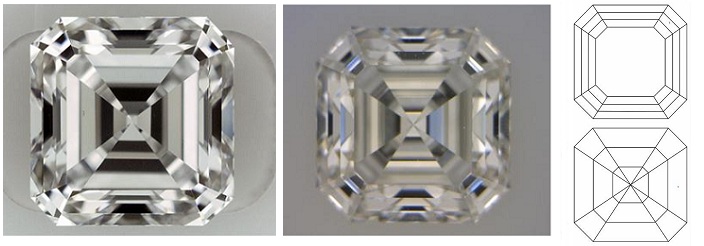
1.02 Carat E Color VS2 and 1.31 G Color VVS2 with 3 crown and 3 pavilion steps
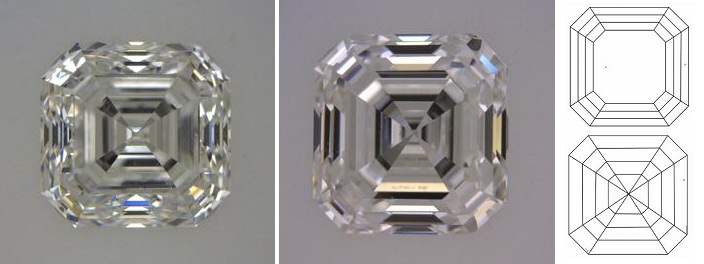
1.01 Carat D Color VS1 and 1.00 G Color VS1 with 3 crown and 4 pavilion steps

1.00 Carat D Color VS1 and 1.66 H Color SI1 with 3 crown and 5 pavilion steps
Ultimately, the choice of facet structure depends on the nature (shape) of the rough crystal and the decisions a cutter makes with it. At this point, I know what you are probably thinking of now: “Which is the best or recommended facet patterning I should get?”.
Well, there really isn’t any right or wrong answers to this question. Each combination can yield a superb looking stone if it is cut correctly to good proportions and angles. Vice versa, you can expect to see ugly looking Asscher diamonds if they are cut poorly.
The onus is on you to make the right call on the right stone. Don’t worry, I’ll show you how to select diamonds with the best optics in a while. But first, I want to show you some of the criteria I personally use for choosing a great looking Asscher cut.
Best Proportions For Asscher Cut Diamonds
There are also two primary characteristics you want to pay attention to when looking at the proportions of an Asscher diamond. These are depth and table size percentages which can be found in the grading report.
In general, I recommend looking out for stones with a depth between 60% and 65% and a table size between 60% and 67%. But I want to emphasize that these numbers are not hard and fast rules. What really matters most when selecting an Asscher cut diamond is its visual properties.
| Excellent | Very Good | Good | Fair/Poor | |
|---|---|---|---|---|
| Table % | 60% – 67% | 58% – 68% | 56% – 70% | Outside Ranges |
| Depth % | 60% – 65% | 58% – 67% | 57% – 69% | Outside Ranges |
| Polish/Symmetry | Excellent – Very Good | Good | Outside Ranges | |
| Length to Width | 1.00 – 1.05 | 1.05 – 1.10 | 1.10 – 1.15 | Outside Ranges |
| Girdle Thickness | V. Thin – Slightly Thick | V. Thin – Thick | Outside Ranges | |
| Culet Size | None | Very Small | Small | Outside Ranges |
* Note: The parameters in this table should be used as a reference only. It is best to use videos to view the diamond in motion or to see the stone physically to determine its scintillation pattern. The use of an ASET scope will also be very useful for determining the optical characteristics of the diamond.
It does take some experience to cherry pick Asscher cut diamonds that have superb light return and patterning. Below are 2 examples of Asscher cut diamonds that have superb light return and patterning.
Feel free to click on the images below to watch their video listings and hopefully, this gives you a better idea of what to look out for when buying an Asscher cut diamond.
Length to Width Ratios For Asscher Cut Diamonds
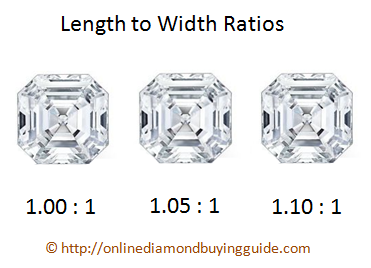
Ideally speaking, you should only consider Asschers with length-to-width ratios between 1.00 – 1.05 : 1. Anything smaller or larger than that, the diamond will appear off-square and look awkward.
Recommended Clarity and Color Ratings for Asscher Diamonds
Being step cuts, Asschers have reduced brilliance and scintillation compared to the brilliant cut diamonds (e.g. round). As a result, material flaws and inclusions tend to show up easily.
From experience, most diamonds below the SI1 grade will not be eyeclean and I would recommend buying VS2 clarity or better. As you can see in the examples above, the SI1 diamond is something I would avoid as the black inclusions may be visible to the naked eyes.
If you are buying a large carat size (> 1.5 ct) Asscher diamond, I would recommend a VS1 clarity or better grade to stay eyeclean.
The most important thing to take note is that it is compulsory to visually inspect diamonds for eyecleanliness before you make a purchase.
When it comes to color, I would recommend a minimum of G color if you are color sensitive and want an icy white diamond. This is because step cut diamonds tend to trap more body color due to their light return properties.
Don’t Forget to Check The Windmills!
Here’s a major tip most jewelers are clueless about. And, even if they do have some knowledge of this, they might not share it with you (for obvious reasons because most Asschers in the market are poorly cut!).
In Asscher cuts, the “windmills” in the diamond should extend all the way into the middle of the stone and converge into a single point. This will create a balanced and pleasing outlook that also helps in the stone’s light performance.
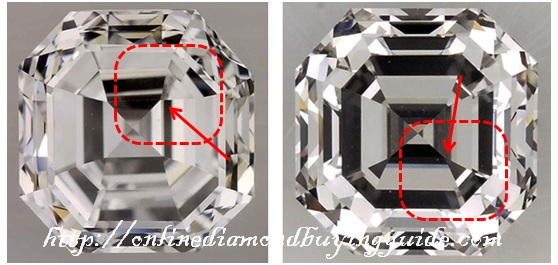
The “windmills” terminate before they reach the middle…
In my personal opinion, if the “windmills” join up before reaching the center, they are telltale signs of a poorly proportioned diamond.
Having performed a number of physical comparisons of such diamonds, I can tell you these diamonds usually lack a “hall of mirrors” effect which gives the Asscher its characteristic flavor.
Case Study: 2 Asschers With Similar Proportions But Look Different
I know from experience that most people will take my recommendations for ideal depth and table proportions as gospel when shopping for Asscher cuts.
And I will say this again. The table of proportions above are meant to be used as a guideline and it is impossible to estimate the light return of an Asscher diamond by numbers alone.
The key to selecting a well cut Asscher is to utilize videos/photography to inspect the visual properties of the diamond. As a case study, let’s take a look at 2 Asscher cut diamonds that have very similar proportions on paper.
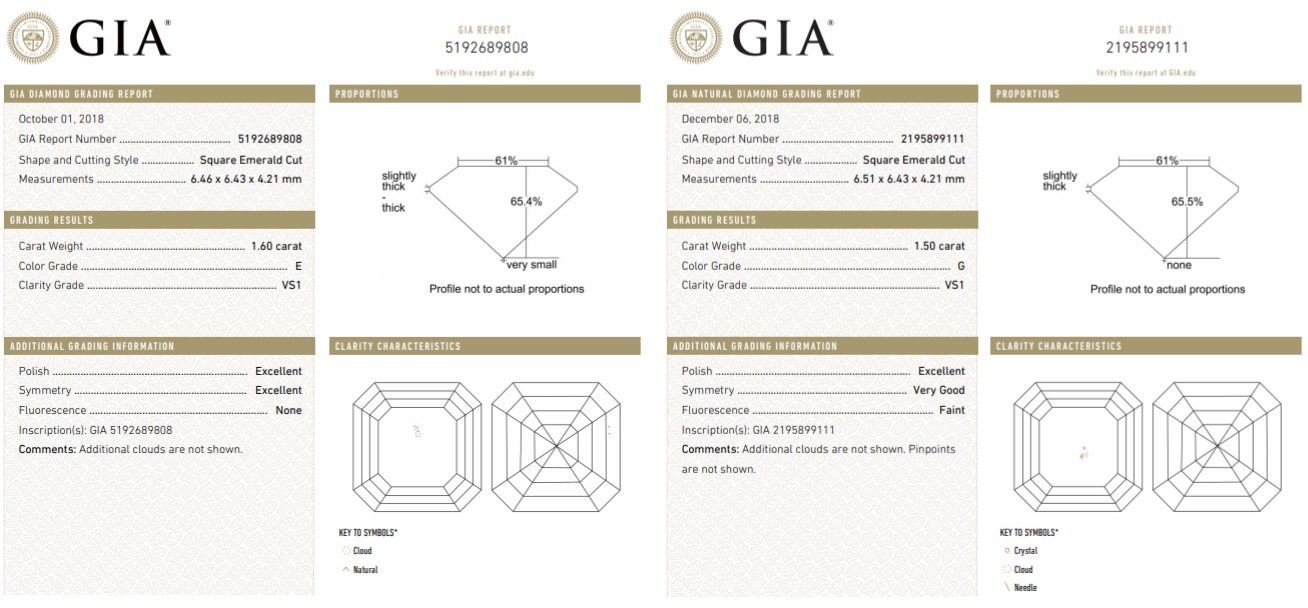
If you didn’t know better, you might assume that both diamonds would have identical appearances because of their identical proportions. You could even argue that the diamond with Excellent/Excellent polish and symmetry would be the better of the two.
However, the reality is far from that.
The diamond on the left has significant issues with light leakage under the table and has poor contrast patterning. By my definition, this is a poorly cut Asscher despite it having GIA Excellent ratings! Most newbies think an Asscher will be well cut if it has Excellent ratings for polish and symmetry.
However, what most consumers don’t understand is that the symmetry grade on a lab report simply refers to “meet point symmetry” and how well the facets meet at junction points. The Symmetry rating is NOT an indication of optical precision or light performance!
On the other hand, the diamond on the right has a strong light return and has a much more appealing look than the other diamond. On paper, this diamond only has a Very Good symmetry and Excellent polish rating.
I hope this case study has shown why visual videos are extremely important when selecting an Asscher cut diamond!
Best Asscher Cut Engagement Ring Settings And Designs
If you are looking for ideas for your Asscher cut diamond ring, check out some of my all-time favorite (and affordable!) designs below. Hopefully, this will help you in your search!
Simple four prong settings allow plenty of light to enter the stone and provide sufficient security.
Two tapered baguette diamonds flank each side of the shank and frames the center diamond.
The Asscher cut looks breathtaking in vintage style settings with intricate detailing and geometric features.
This french Cut pavé setting is created to maximize the amount of light that hits the diamonds from all sides.
Regardless of how you decide to wear it, an Asscher cut diamond will speak volumes about who you are. To view 100s of different breathtaking designs, head over to Blue Nile and James Allen to browse through their ring selections.
Summary And Recap: How to Select an Asscher Cut Diamond
To recap, here are my recommended guidelines for buying an Asscher cut diamond:
Depth: 60% to 67%
Table: 60% to 65%
Polish/Symmetry: Very Good or Excellent
Length to Width Ratio: Within a range of 1.00 to 1.05
Color: G or better
Clarity: VS2 or better
When shopping for Asscher cut diamonds, it is extremely important to view magnified videos of the diamond in neutral lighting conditions. This allows you to have an unbiased assessment of the diamond’s performance and contrast patterning.
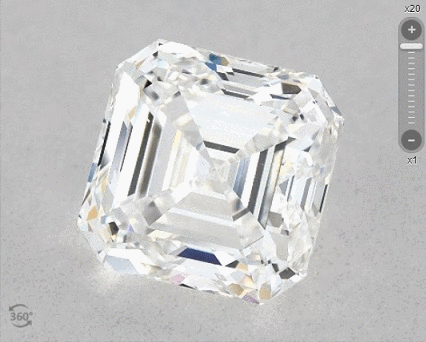
Related Articles
Leave A Comment

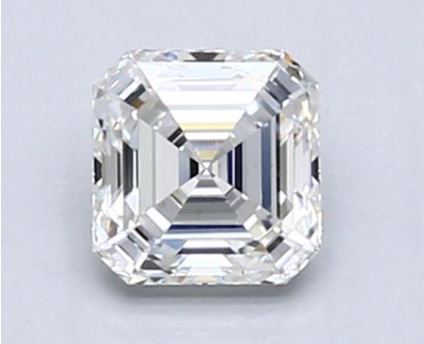
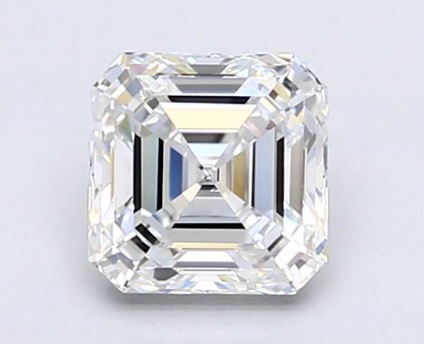
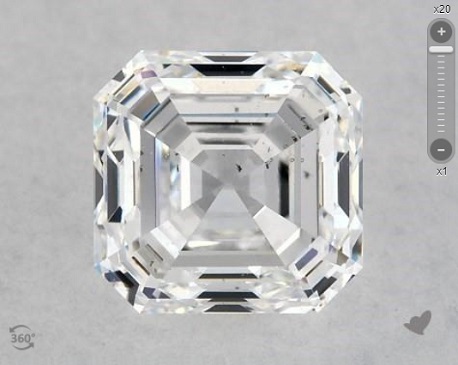
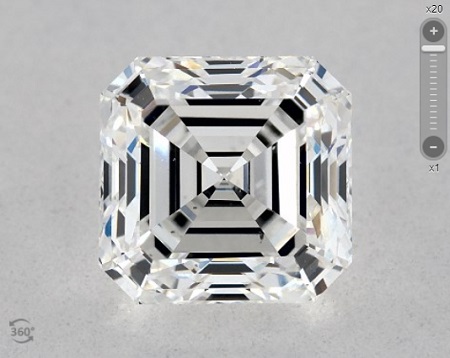
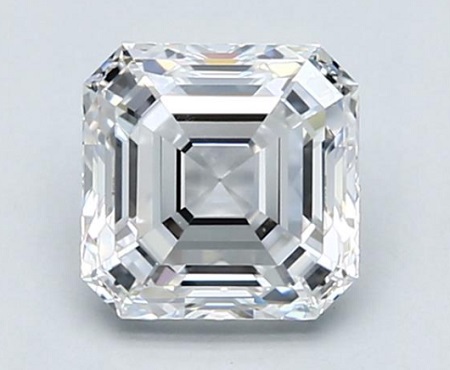
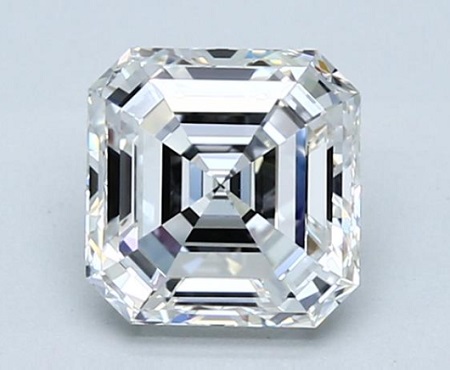
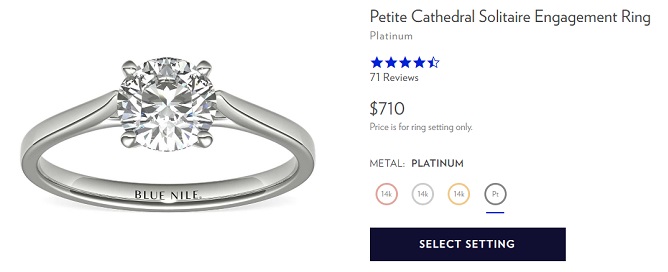
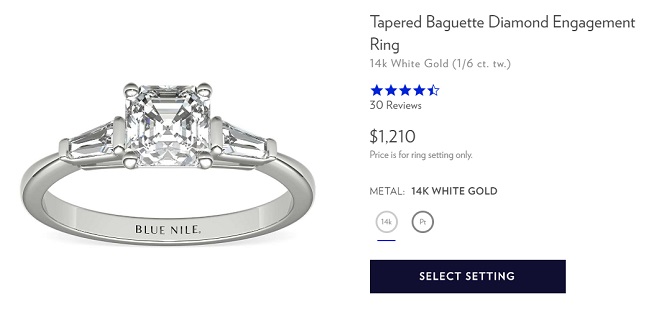
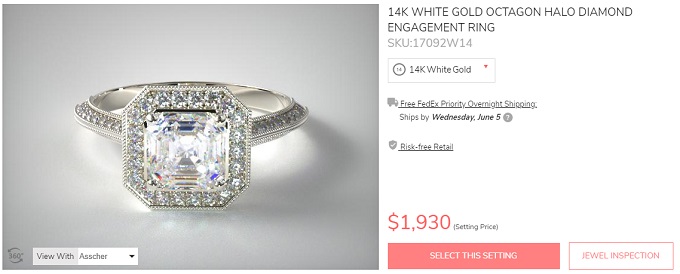
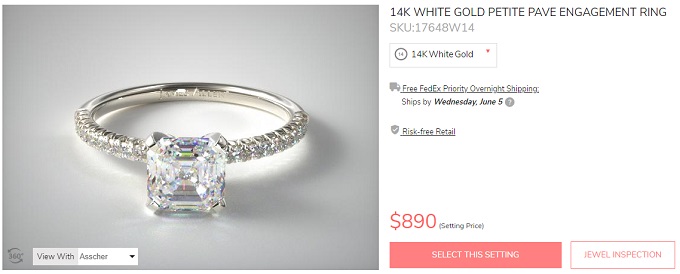
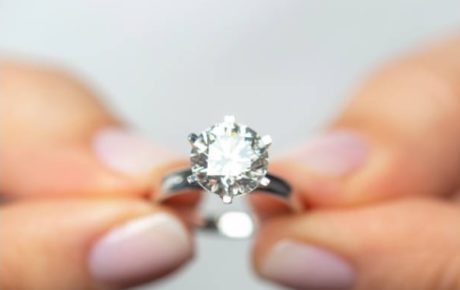
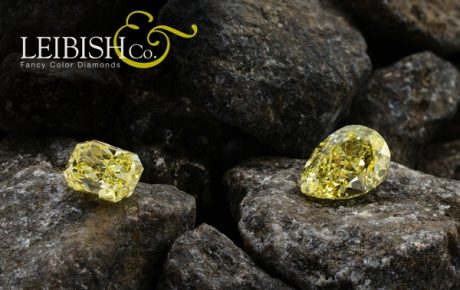
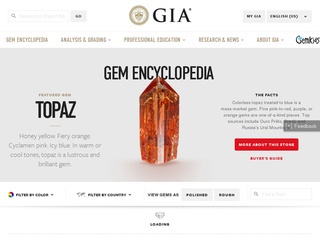
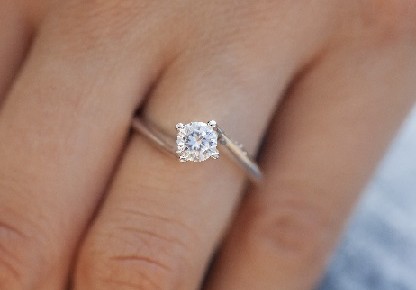









16 Comments
I do not understand the portions about having ‘windmills’ in the Asscher-cut diamond. How do we create it and how do we remove it from diamond?
If I understand you correctly, the question you are asking pertains to diamond cutting. This is beyond the scope of our website itself since we are focused on helping consumers buy diamonds and not so much on addressing technicalities for professionals in the trade.
Hey Paul,
First, thanks for the amazing site! Your knowledge has certainly proven useful as I’m hunting around for the perfect rock. :)
I’ve been pretty partial to picking out an Asscher cut, so I figured this would be the best place to pick your brain: what do you think of this? 1.11 carat / G / IF / GIA certified
The same rock on BlueNile goes for about $800 more, which makes me feel better about my hunting skills, but at the same time without the ASET image I’m a little trigger-shy.
How do you think the diamond above would compare to the following one (1.21 carat / G / VS2 / AGS)? ASET seems to look pretty good for a bigger rock, but doesn’t seem “eye clean” to me.
Thanks again for all of your help! I’d also love to pick your brain on more specific buying for lab-created options, since they’re basically 99.9% IGI certified without ASET or IdealScope images.
Cheers,
Brad
The first diamond would be a better choice as it has better cut quality. If you are looking for lab created diamonds, Brilliant Earth would be the dealer to look at as they are the largest retailer of them and you stand a better chance of finding something decent there. The videos of the diamond can actually reveal cut information and help towards making an educated decision.
Read this: https://beyond4cs.com/lab-created-diamonds/
I purchased a 2.01 carat asscher diamond: GIA, I-color, VVS1. I’m concerned bc based on “standard” asscher 2 carat renderings it should measure closer to 7mm wide and long. Mine per the GIA cert shows the measurements are closer to a 1.5 to 1.8 carat diamond…mine measures at 6.69mm x 6.71. Table is 63%, depth is 69.7% and a very thick girdle.
Am I paying too much at $9700? Will this stone face up too small for 2 carats to be at the 2 carat price?
Thanks in advance!
It’s hard to say whether you found a well cut diamond as there are too many variables involved. The carat weight and measurements by itself mean nothing compared to how the diamond looks like or will sparkle because of cut quality. The depth of the diamond is indeed on the steeper side and that will make the diamond look smaller. But that doesn’t mean it’s going to have poor performance. If you want me to help you assess the diamond, you would have to provide me with properly taken videos and photos.
Is there any reason why an asscher cut diamond is cheaper than a round? I have a hard time finding one that meets my specifications and the jeweler is telling me that they are very rare. If something is rare, wouldn’t it make sense for it to cost more? The asschers that I come across are a lot less expensive
Asscher cuts are “rare” because of their low demand. That doesn’t make them more expensive. The reason they are less expensive (usually by 20-30% less) is that the step cut is actually an efficient cutting method because it can reduce the amount of rough wastage.
I’ve been going through your website for a few hours now and the wealth of information is most helpful, although a bit overwhelming! I’m in the market for upgrading my ring, and my heart is stuck on an asscher. Somehow, I’m seeing conflicting information on what would qualify as a good asscher, mostly because I’m looking for a valued option; as opposed to the money is no bar option !
I’m not too crazy about white diamonds, so the diamond I’m looking at has a faint bit of color, which I’m actually ok with. However, I’m very keen on not making a bad investment, as I may sell this ring later and again upgrade. Mostly; I’m interested in knowing whether from the GIA report it’s possible to understand if this diamond would be a good purchase, I’m being quoted a price of about USD 4000 for this diamond. My jeweller says this diamond is very special, I’m not sure as he may not be selling too many asschers and perhaps may simply want to get rid of it, and though I did not see it through a magnifying glass, it did look good to me in the store!
I know you cannot conclusively figure out the characteristics from only a GIA report, but I’m mostly looking for help to know if you see any major red flags, or you think this would be a worthless buy. It would really really help me to have your views on this, as I’ve simply gone mad with the amount of available information, so much that I’ve already spent 3 months debating this purchase :((
I have the certificate. And the best picture I have of the diamond, it’s a bit hazy, but it looks much better in person. Please do let me know if you need more information, this would really help me! Much appreciated!
Without tangible video or photographic information, I cannot provide you with a constructive assessment of the diamond. As I had said in this write up, the visual appearances are key to choosing a fancy shape asscher diamond.
Hi, Paul,
I recently purchased a yellow diamond that is faceted in the Asscher cut from James Allen.
Paul, I meant to state that I noticed the GIA report posted on your website as an example has the Asscher listed as a Square Emerald Cut. The “Asscher” I purchased has the same cut listed on the report.
Does GIA list Asscher cut diamonds (and possibly colored gems) on their lab reports as “Square Emerald Cut” because the Royal Asscher cut has been patented?
Thank you so much for your advice to consumers!
Jan
GIA uses a technical description of the diamond’s cutting style that may not coincide with what retailers usually use to define as Asscher cuts. GIA gives a description that is closest to what they see when they grade the diamond and many different types of cutting styles can fall under the Asscher umbrella. Now, I would say that square emerald cut is a pretty common description they use for Asscher cuts. Now, the Royal Asscher cut is a “branded” type of cutting style and GIA actually defines it as a cut cornered square step cut. The older GIA reports use this as a description while the newer ones actually put in the brand name “Royal Asscher cut” as part of the description as well.
All other aspects being equal, how much % more expensive could be justified to get a Royal Asscher Cut vs a regular Asscher Cut?
I personally won’t pay any more than 10-15% more for a branded diamond when I could buy a great looking stone by choosing it myself.
Paul, had a question about the best time to buy a diamond, not in connection with sales but when do the big name online retailers have the most inventory, giving shoppers the biggest selection? I noticed that while shopping online at James Allen before Valentines Day for example, that the inventory started to running low (which makes sense), so not being in a hurry, I’m thinking, they have to restock soon right?
James Allen does restocking throughout the year and there’s really no “magic” timing. For Asscher cut diamonds, inventory is generally smaller because of low demand. Round diamonds will have the biggest turnover because of their popularity compared to Asscher. So, it isn’t really a matter of it being Valentine’s Day.